AyinBase / Ayin Beis with R' Paltiel
ThursdayNight 29 Iyar 5773
Page
21 (chuf aleph). 8th
line of the page –
(line
begins: 'ha-atzmi...') For text, click: Here.
We
are dealing with Kabbalah idioms that will be followed by chassidus.
The
term essence is totally illusive. There is not an essence/etzem
quality within worldly parameters. The world is past present and
future and front, back, left, right and up and down – meaning it is
an assembly of different parts and dimensions.
So
to get a sense of this, we draw attention to the life element that is
in the world... think of recognition of a person – it relates not
to any of their features, but to their essential life... it is like
a glimpse of essence within a worldy setting...
Everything
wants to be what it is... not to out do the next guy, but he just
relates to who he is... this is an essential element... a Godly spark
within him. And we cannot define it and correlate it to any
functionality... and this essential element carries its own sense of
oneg/pleasure. There is not an external cause for the pleasure –
it has a Godly truth itself.
And
it is for this reason that each thing, 'wants to be what it is'.
There
is a pleasure that can be sensed. And a deeper level that cannot be
sensed.
Mind
– chochmah and binah – is a level of which we are aware. In the
external world the topic of sechel/mind and reasoning has been
stripped of any meaning and life element. They will even say any
sechel that has an element of soul is false. They work on the
deductive level without working on the level of 'what is this all
about'.
Real
sechel/mind actually carries the neshamah with it. The advantage of
sechel/mind over midot/emotions is tht is nullifies itself before the
truth... it allows itself to be a vessel for truth.
Our
sechel/mind is based on the principle that there is a First Being,
and thus it has a source. The sechel relates to this primary being.
External sechel, says that mind itself creates
the whole reality, without
a primary reality...!
Real
sechel is not nullified to nothing,
but rather to primary reality.
It reflects the truth of the neshamah/soul.
Chochmah/wisdom
is where the tynug/pleasure is sensed.
The
question is 'what is the primary reality'. For kedusha, He is the
first reality. In klipa, the physical is the first reality!
Fortunately
since you have a soul, no matter how much external sechel/mind is
pushed on you, you keep it at arm's length and say, 'hey, something
doesn't jive!', and hence he is able to venture out of it...!
At
the new paragraph on p21 (chaf aleph). On Yom Kippur it is like
Shabbat, so why don't we eat. Yom Kippur is the actualization of the
Godly influence from above... and in the King's throne room one
doesn't eat.
God
says 'I will appear in a cloud'. This is the could of incense... and
incense relatues to tshuvah/return.
In
summary: the principle that was identified in the last couple of
page – 'to understand the principle of ohr elyon/higher light.
Despite that fact that we are in the world and have our outlook based
on this, but this does not constrain us to worldly definitions...
there is a drawing down of essence,
an essential intent...
If
awareness were to be attributed to our experiences then our
differences could not be bridged. But due to the fact that the real
presence is the essence – and that all is based on the First Being
and is based on his doing, then there is a drawing down of the ohr
elyon / higher light that is able to unite all different aspects.
Go
into anyone's home – there's a variety of furnishings – but what
what brought them together is the human spirit, not their function.
And if we go to the level of the human spirit of the home then all
the objects are equal since they are there for one purpose.
This
is the metaphor and it is the same in the analog.





















